Techno-Economic Analysis of Glazed, Unglazed and Evacuated Tube Solar Water Heaters
Abstract
1. Introduction
2. System Description
3. Environmental and Metrological Data
4. Collector Types
5. Simulation
Mathematical Models
6. Results and Discussion
6.1. Backup Fuel Analysis
6.2. Annual Heating Energy Saved
6.3. Solar Fraction
6.4. Financial Analysis
7. Conclusions
- In terms of backup fuel analysis, two unglazed solar collectors saved more energy as compared to the other two types of collectors. Gujrat showed the greater energy saving potential, than the other sites, for the two evacuated and glazed collectors, while for the two unglazed collectors, Madhya Pradesh had the greater potential.
- For GHG emissions reduction in terms of CO2, two unglazed collectors reduce more GHG emissions as compared to the other two types of collectors. Haryana reduced more GHG emissions, as compared to the other sites, if two glazed and evacuated collectors were used, while Madhya Pradesh showed more reduction in GHG emissions for two unglazed collectors.
- For annual heating energy saved, Gujrat showed better results among all other sites for all three types of collectors.
- Solar fraction increased as number of collectors increased for three evacuated and glazed collectors. Haryana and Gujrat were the best among the selected sites, while some sites even received 100% solar fraction after using two unglazed collectors.
- Benefit to cost ratio for unglazed collectors was better than the other two types of collectors, while the equity payback period for evacuated SWHs was highest among the other two SWHs.
Author Contributions
Funding
Acknowledgments
Conflicts of Interest
Nomenclature
| Symbols | Represents |
| Ac | Collector area given in m2 |
| f | Fraction of the total monthly load given by SWHs in % |
| fdirt | Losses encounter by SWHs due to dirt |
| FR | Heat removal factor of collector |
| FRUL | Thermal losses of solar collector in ((W/m2)/°C) |
| Conversion factor | |
| G | Global incident solar radiation in W/m2 |
| HT | Monthly average daily solar radiation falling on the collector surface per unit area in (KWh/m2/d) |
| L | Total heating load in a month in GJ |
| N | Days in a month |
| Energy collected per unit collector area in W/m2 | |
| Ta | Average ambient temperature in a month in °C |
| Tw | Minimum acceptable water temperature in °C |
| Tm | Mains water supply temperature in °C |
| Tref | Reference temperature (100 °C) |
| ΔT | Difference of temperature between the working fluid entering the collector and outside in °C |
| UL | Overall heat loss coefficient of the collector in ((W/m2)/°C) |
| Transmittance of cover | |
| Short wave absorptivity of the collector |
References
- Seetharaman, G. Coal Here to Stay Despite India’s Ambitious Goals for Renewable Energy. The Economic Times. 2020. Available online: https://economictimes.indiatimes.com/industry/energy/power/india-will-not-be-able-to-achieve-its-renewable-energy-targets-anytime-soon/articleshow/69286279.cms?from=mdr (accessed on 26 November 2020).
- Latitude and Longitude Finder, Lat Long of Indian States. Maps of India. 2020. Available online: https://www.mapsofindia.com/lat_long/ (accessed on 26 November 2020).
- India Energy Portal. Indiaenergyportal.Org. 2020. Available online: http://www.indiaenergyportal.org/subthemes.php?text=solar (accessed on 26 November 2020).
- Abd-ur-Rehman, H.M.; Al-Sulaiman, F.A. Techno-Economic Evaluation of Different Types of Solar Collectors for Water Heating Application in Domestic Sector of Saudi Arabia. In Proceedings of the 2014 5th International Renewable Energy Congress (IREC), Hammamet, Tunisia, 25–27 March 2014. [Google Scholar] [CrossRef]
- Rajab, Z.; Zuhier, M.; Khalil, A.; El-Faitouri, S.A. Techno-Economic Feasibility Study of Solar Water Heating System in Libya. In Proceedings of the 2017 8th International Renewable Energy Congress (IREC), Amman, Jordan, 21–23 March 2017. [Google Scholar] [CrossRef]
- Yasin, A. Technical and Financial Assessment of Glazed and Evacuated Tubes Solar Collectors for Domestic Water Heating Application in Palestine. An-Najah Univ. J. Res. A (Nat. Sci.) 2017, 31, 151–172. Available online: https://hdl.handle.net/20.500.11888/2900 (accessed on 26 November 2020).
- Kablan, M. Techno-Economic Analysis of the Jordanian Solar Water Heating System. Energy 2004, 29, 1069–1079. [Google Scholar] [CrossRef]
- Hagos, D.A.; Gebremedhin, A.; Zethraeus, B. Solar Water Heating as A Potential Source for Inland Norway Energy Mix. J. Renew. Energy 2014, 1–11. [Google Scholar] [CrossRef]
- Gautam, A.; Chamoli, S.; Kumar, A.; Singh, S. A review on technical improvements, economic feasibility and world scenario of solar water heating system. Renew. Sustain. Energy Rev. 2017, 68, 541–562. [Google Scholar] [CrossRef]
- Taborianski, V.M.; Prado, R.T. Comparative evaluation of the contribution of residential water heating systems to the variation of greenhouse gases stock in the atmosphere. Build. Environ. 2004, 39, 645–652. [Google Scholar] [CrossRef]
- Lima, J.B.A.; Prado, R.T.A.; Taborianski, V.M. Optimization of tank and flat-plate collector of solar water heating system for single-family households to assure economic efficiency through the TRNSYS program. Renew. Energy 2006, 31, 1581–1595. [Google Scholar] [CrossRef]
- Urmee, T.; Walker, E.; Bahri, P.A.; Baverstock, G.; Rezvani, S.; Saman, W. Solar water heaters uptake in Australia—Issues and barriers. Sustain. Energy Technol. Assess. 2018, 30, 11–23. [Google Scholar] [CrossRef]
- Nahar, N.M. Performance and testing of a natural circulation solar water heating system. Int. J. Ambient. Energy 1988, 9, 149–154. [Google Scholar] [CrossRef]
- Basson, J.A. Using solar energy to heat water in low income housing. Int. J. Ambient. Energy 1982, 3, 187–194. [Google Scholar] [CrossRef]
- Murali, G.; Mayilsamy, K.; Arjunan, T.V. An Experimental Study of PCM-Incorporated Thermosyphon Solar Water Heating System. Int. J. Green Energy 2015, 12, 978–986. [Google Scholar] [CrossRef]
- Notton, G.; Diaf, S. Available Solar Energy for Flat-Plate Solar Collectors Mounted on a Fixed or Tracking Structure. Int. J. Green Energy 2016, 13, 181–190. [Google Scholar] [CrossRef]
- Koholé, Y.W.; Tchuen, G. Experimental and numerical investigation of a thermosyphon solar water heater. Int. J. Ambient. Energy 2018, 41, 384–394. [Google Scholar] [CrossRef]
- Zhang, T.; Yan, Z.W.; Wang, L.Y.; Zheng, W.J.; Su, Y.H. Comparative study on the annual performance between loop thermosyphon solar water heating system and conventional solar water heating system. Sol. Energy 2020, 197, 433–442. [Google Scholar] [CrossRef]
- Touaba, O.; Cheikh, M.S.A.; Slimani, M.E.-A.; Bouraiou, A.; Ziane, A.; Necaibia, A.; Harmim, A. Experimental investigation of solar water heater equipped with a solar collector using waste oil as absorber and working fluid. Sol. Energy 2020, 199, 630–644. [Google Scholar] [CrossRef]
- Balaji, K.; Khan, A.I.; Kumar, P.G.; Iniyan, S.; Goic, R. Experimental analysis on free convection effect using two different thermal performance enhancers in absorber tube of a forced circulation flat plate solar water heater. Sol. Energy 2019, 185, 445–454. [Google Scholar] [CrossRef]
- Kumar, R.; Rosen, M.A. Comparative performance investigation of integrated collector-storage solar water heaters with various heat loss reduction strategies. Int. J. Energy Res. 2010, 35, 1179–1187. [Google Scholar] [CrossRef]
- Tanha, K.; Fung, A.S.; Kumar, R. Simulation and experimental investigation of two hybrid solar domestic water heaters with drain water heat recovery. Int. J. Energy Res. 2015, 39, 1879–1889. [Google Scholar] [CrossRef]
- Google Earth. Map of India. Available online: https://earth.google.com/web/search/india/@20.98801342,82.75252922,257.77508621a,4445122.56713124d,35y,0h,0t,0r/data=CnAaRhJACiUweDMwNjM1ZmYwNmI5MmI3OTE6MHhkNzhjNGZhMTg1NDIxM2E2GZEotKz7lzRAIT1-b9OfvVNAKgVpbmRpYRgCIAEiJgokCd2rt1WjXTNAEd2rt1WjXTPAGV5wMf9RAEFAIf4wvYiHmFDA (accessed on 14 November 2020).
- Duffie, J.A.; Beckman, W.A. Solar Engineering of Thermal Processes; Wiley: Hoboken, NJ, USA, 2013. [Google Scholar]
- Kalogirou, S. Solar Energy Engineering, 2nd ed.; Academic Press: Waltham, MA, USA, 2013. [Google Scholar]




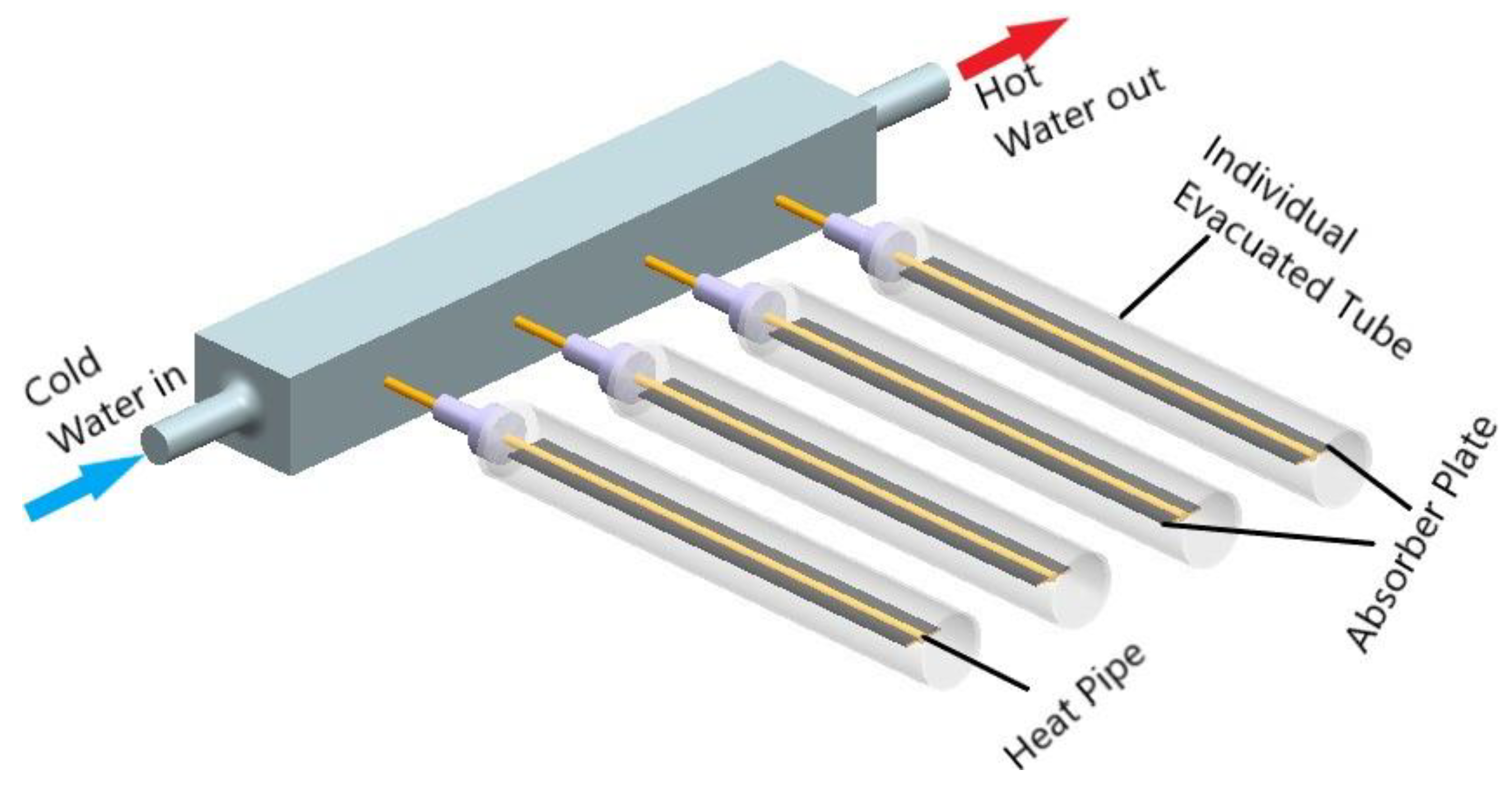
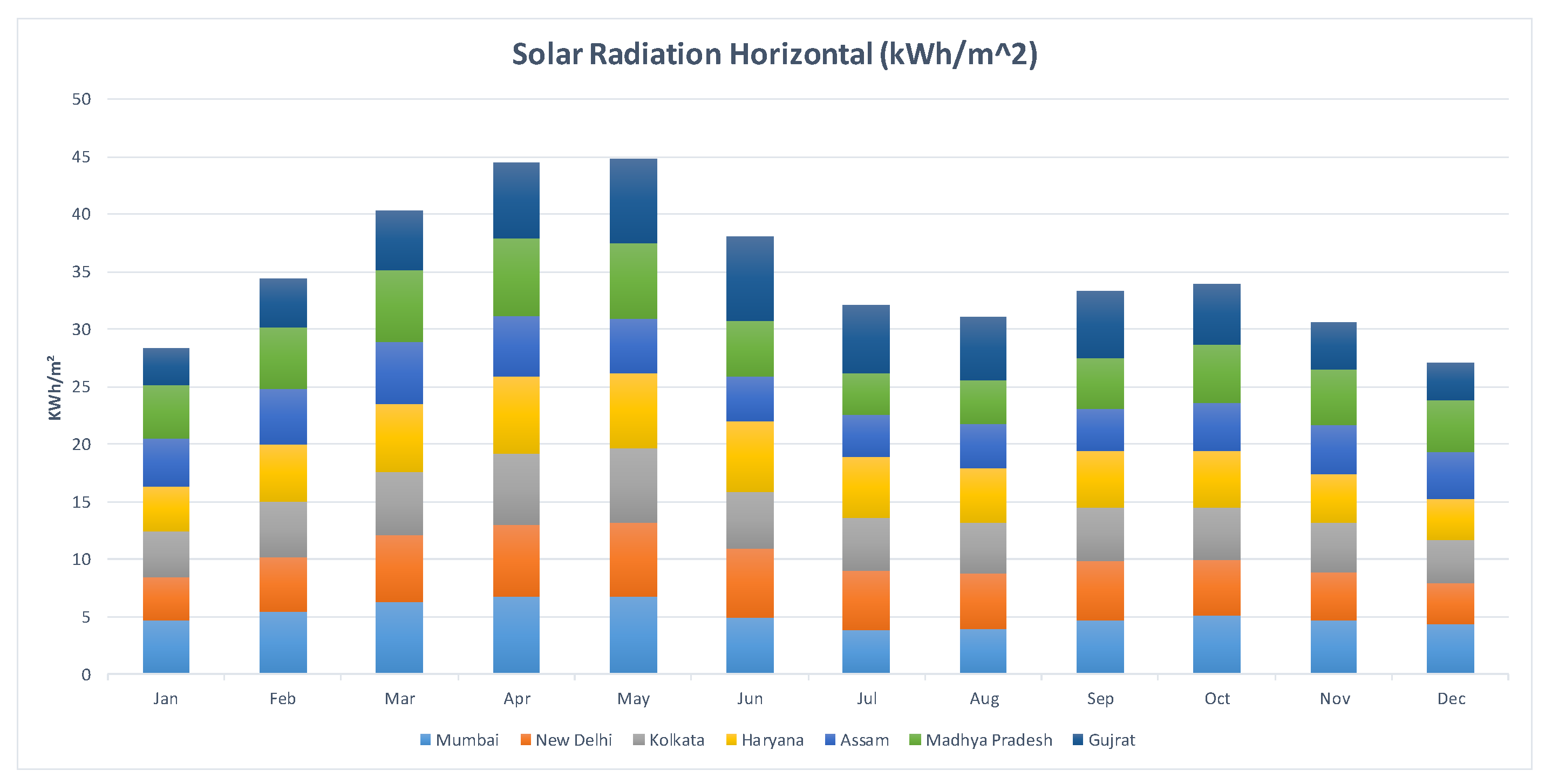
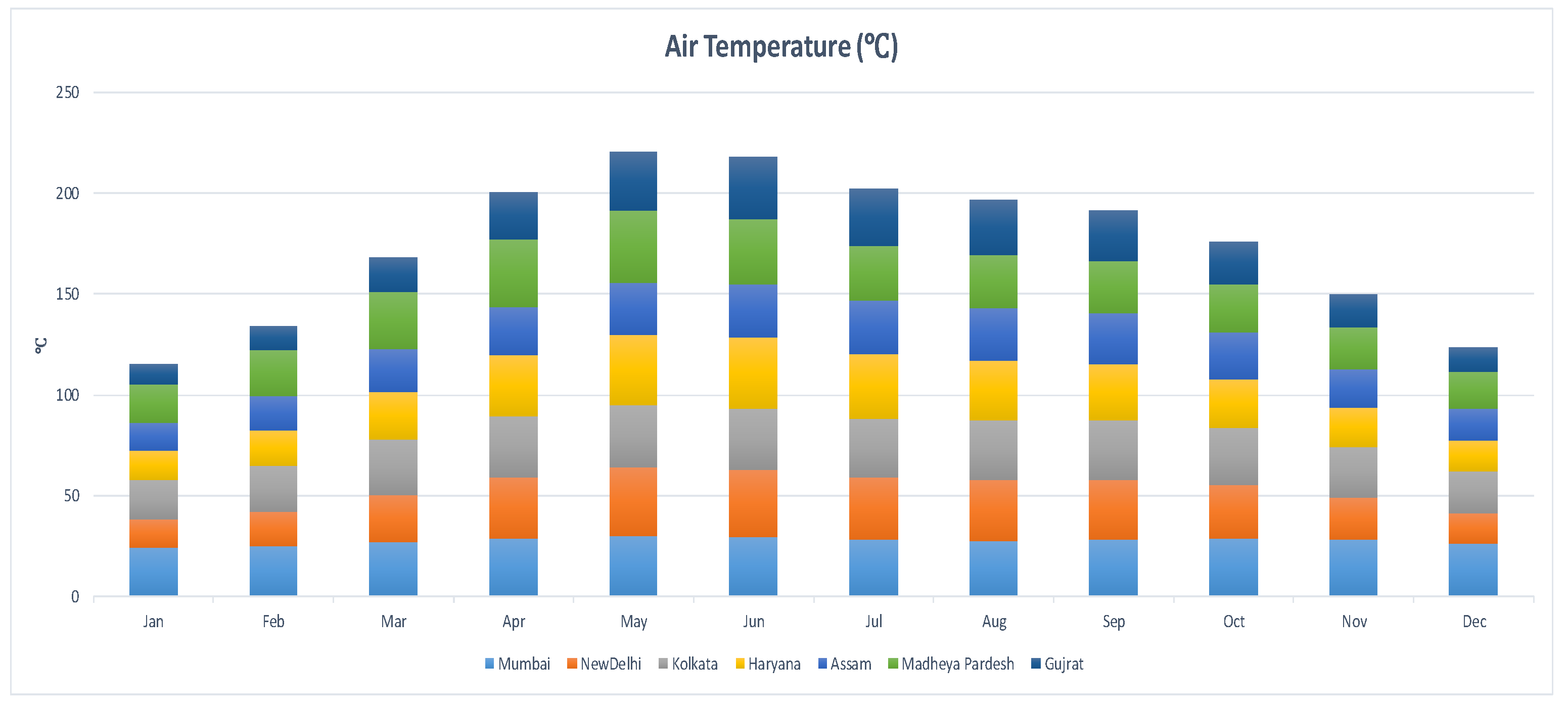
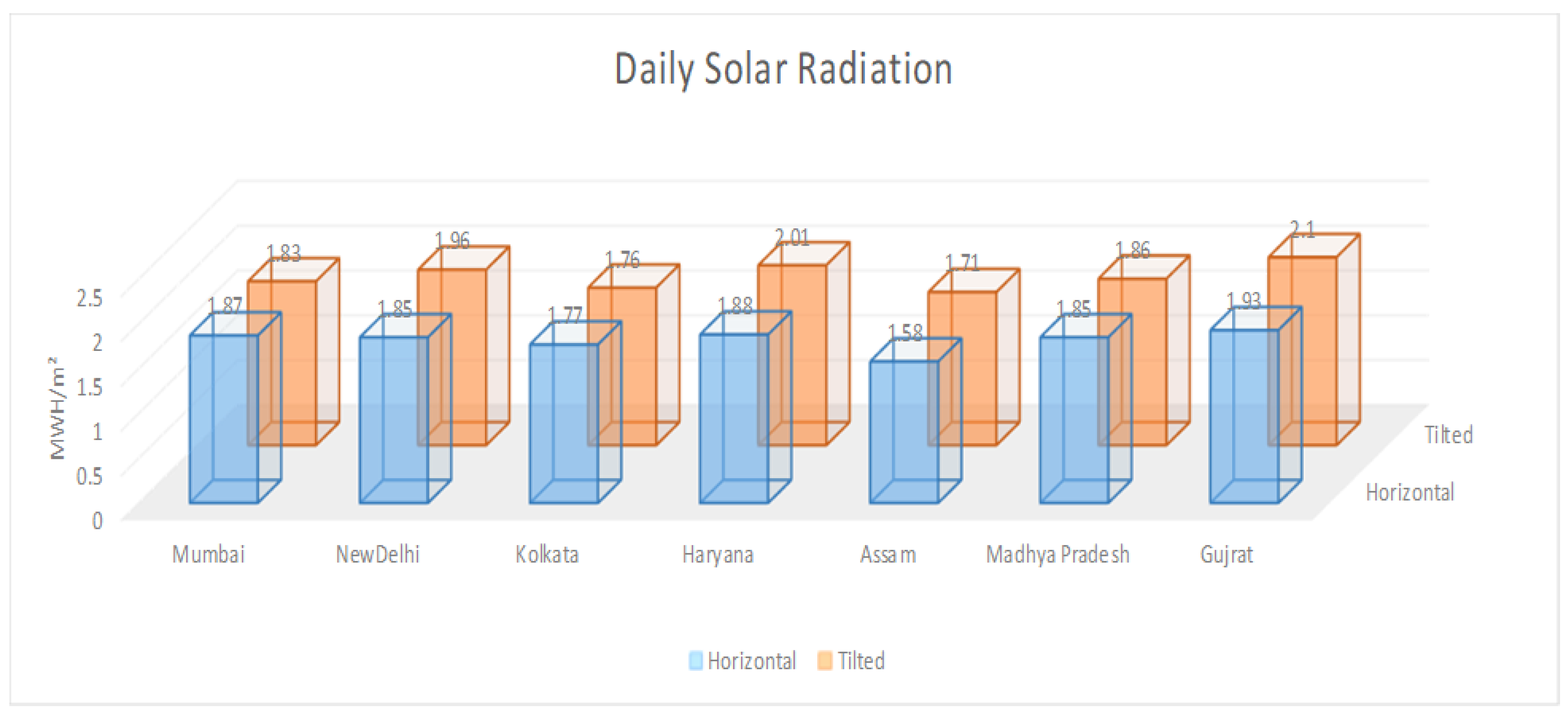
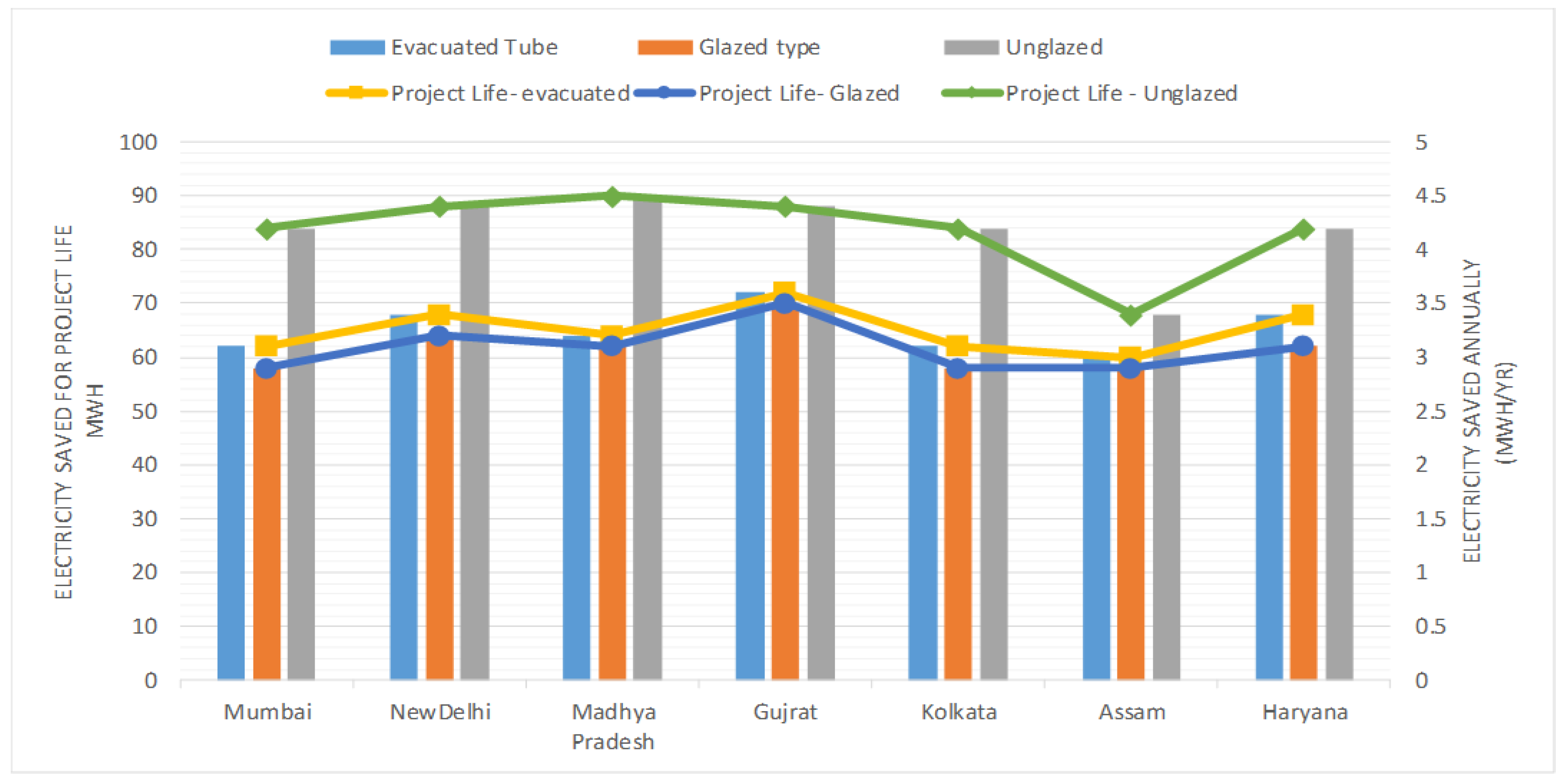

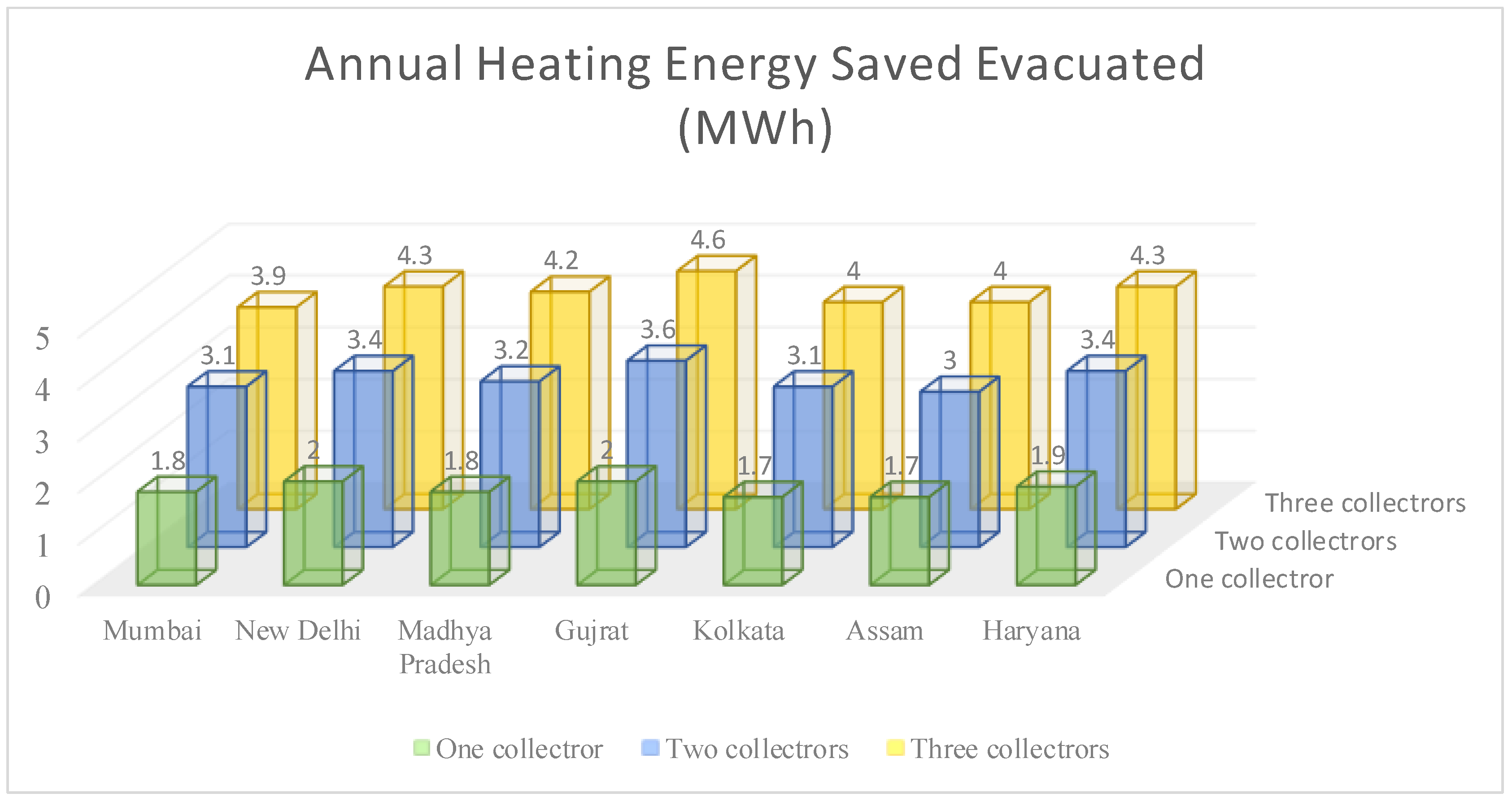


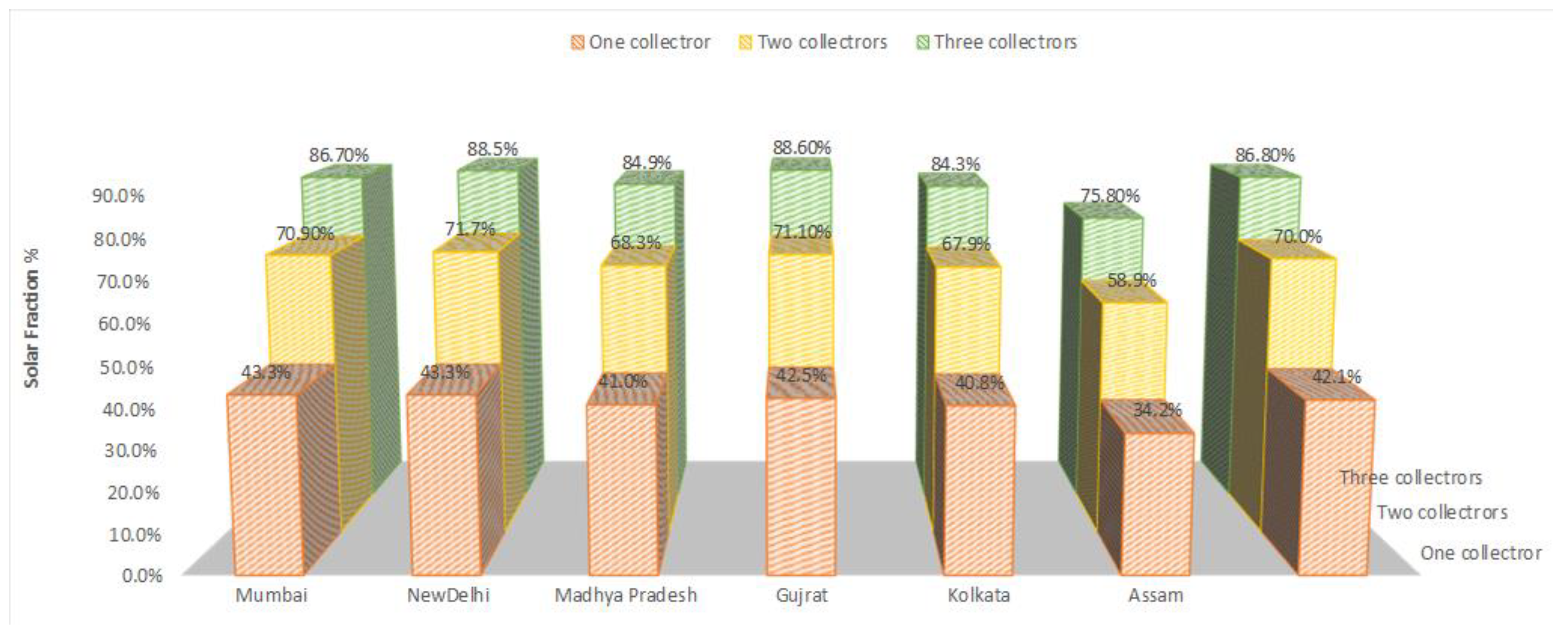
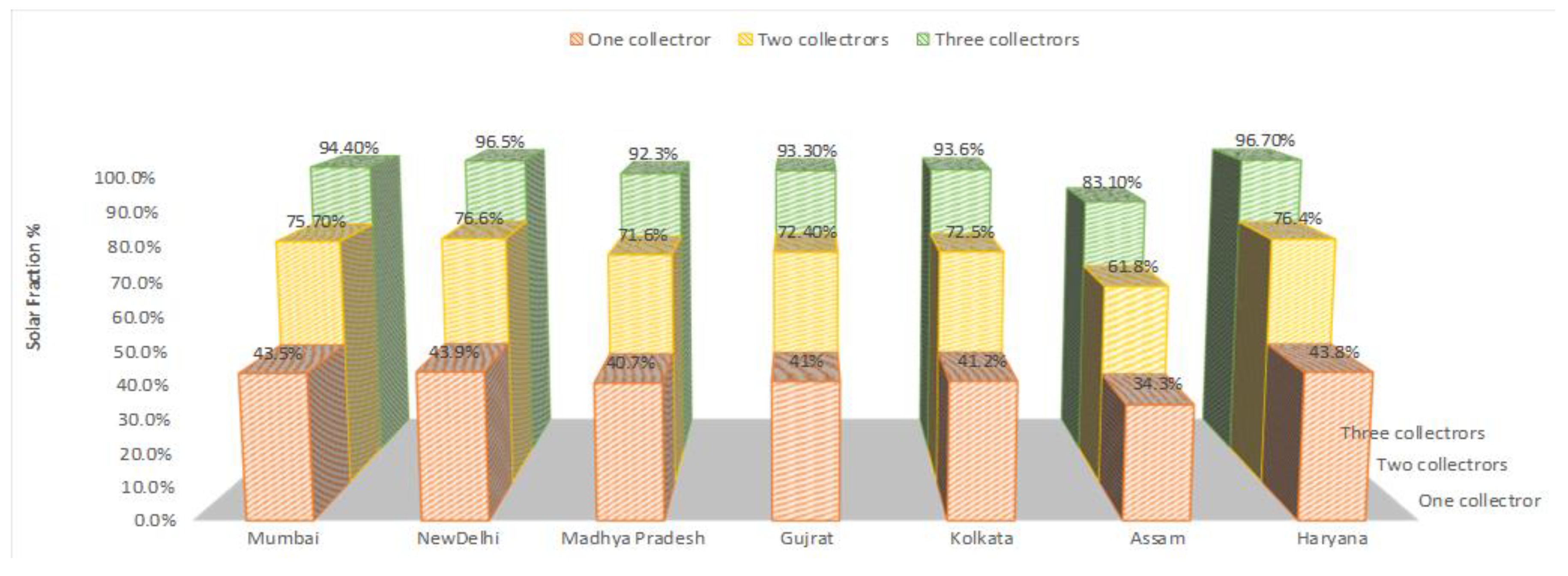
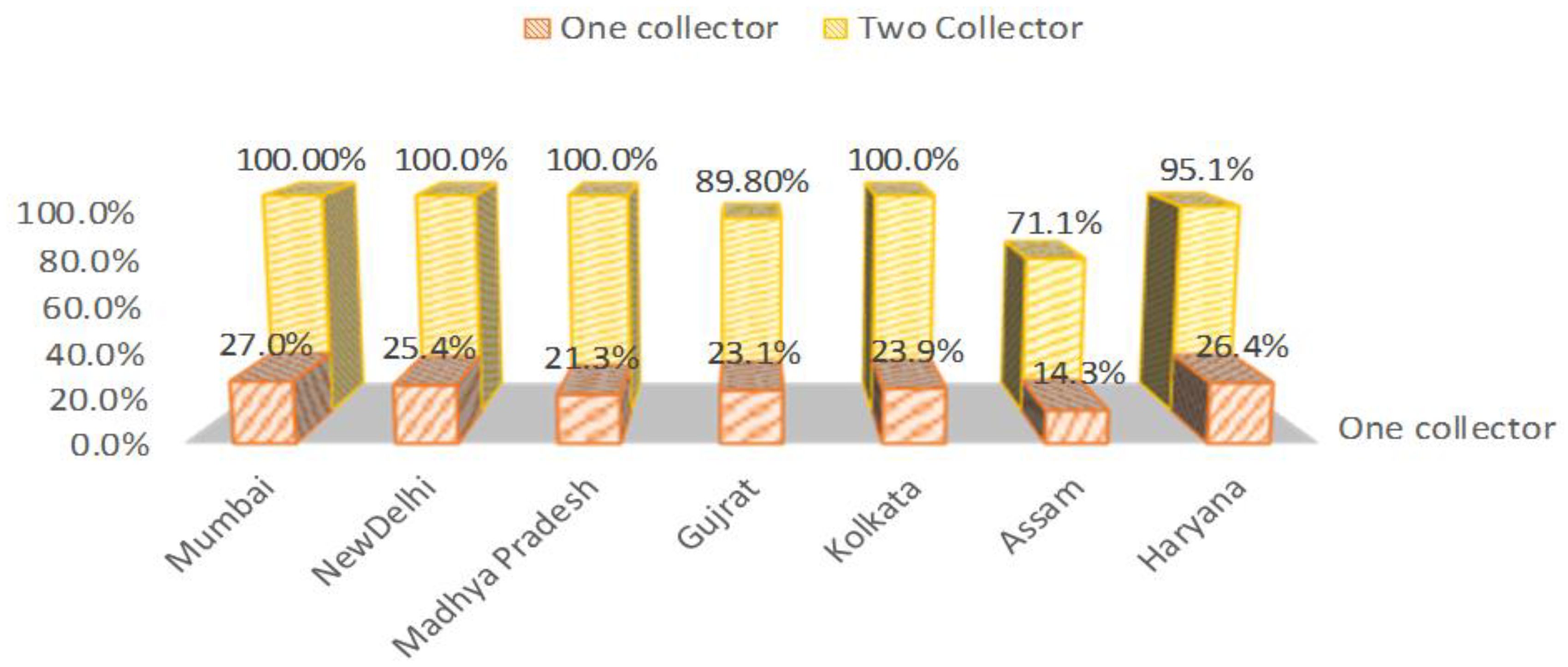
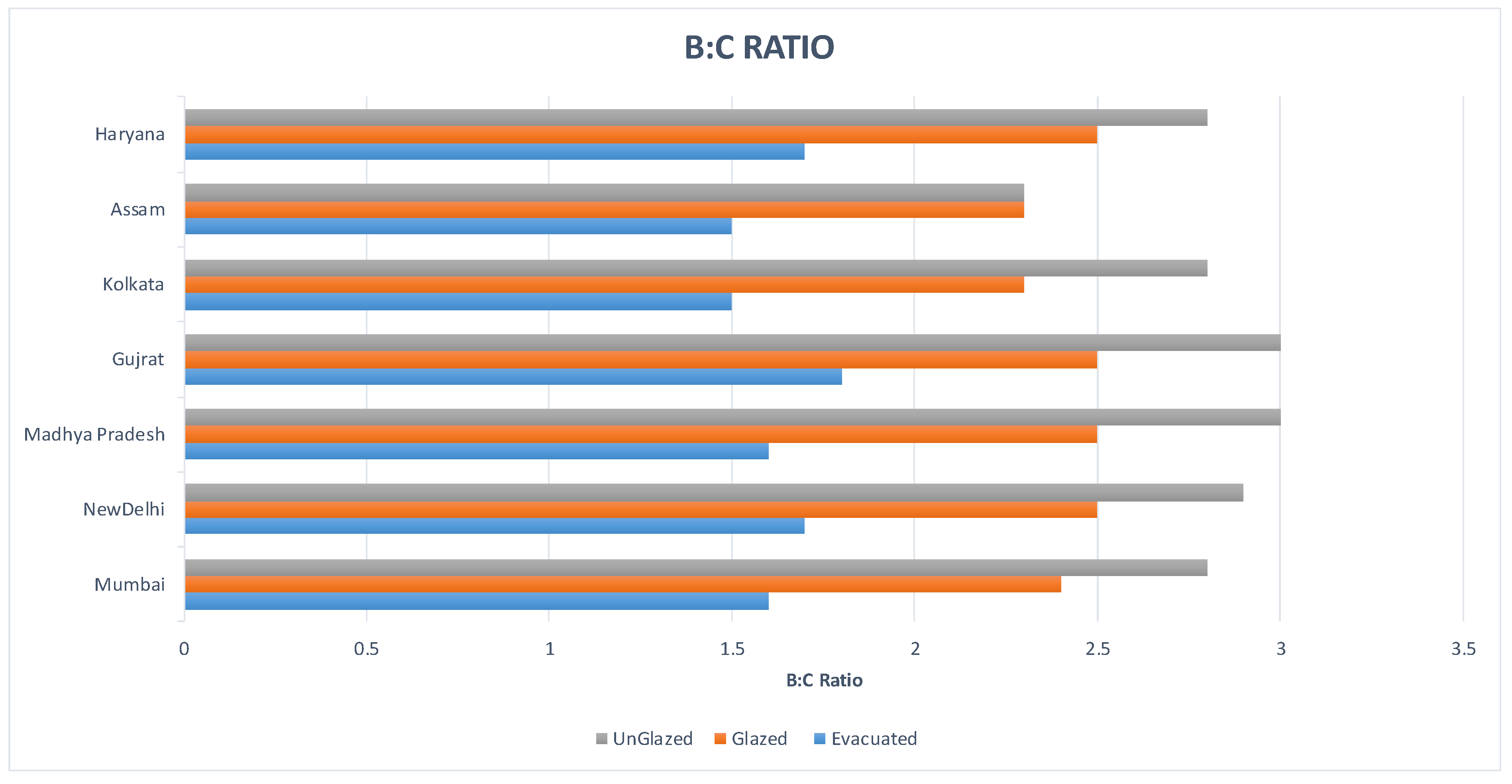
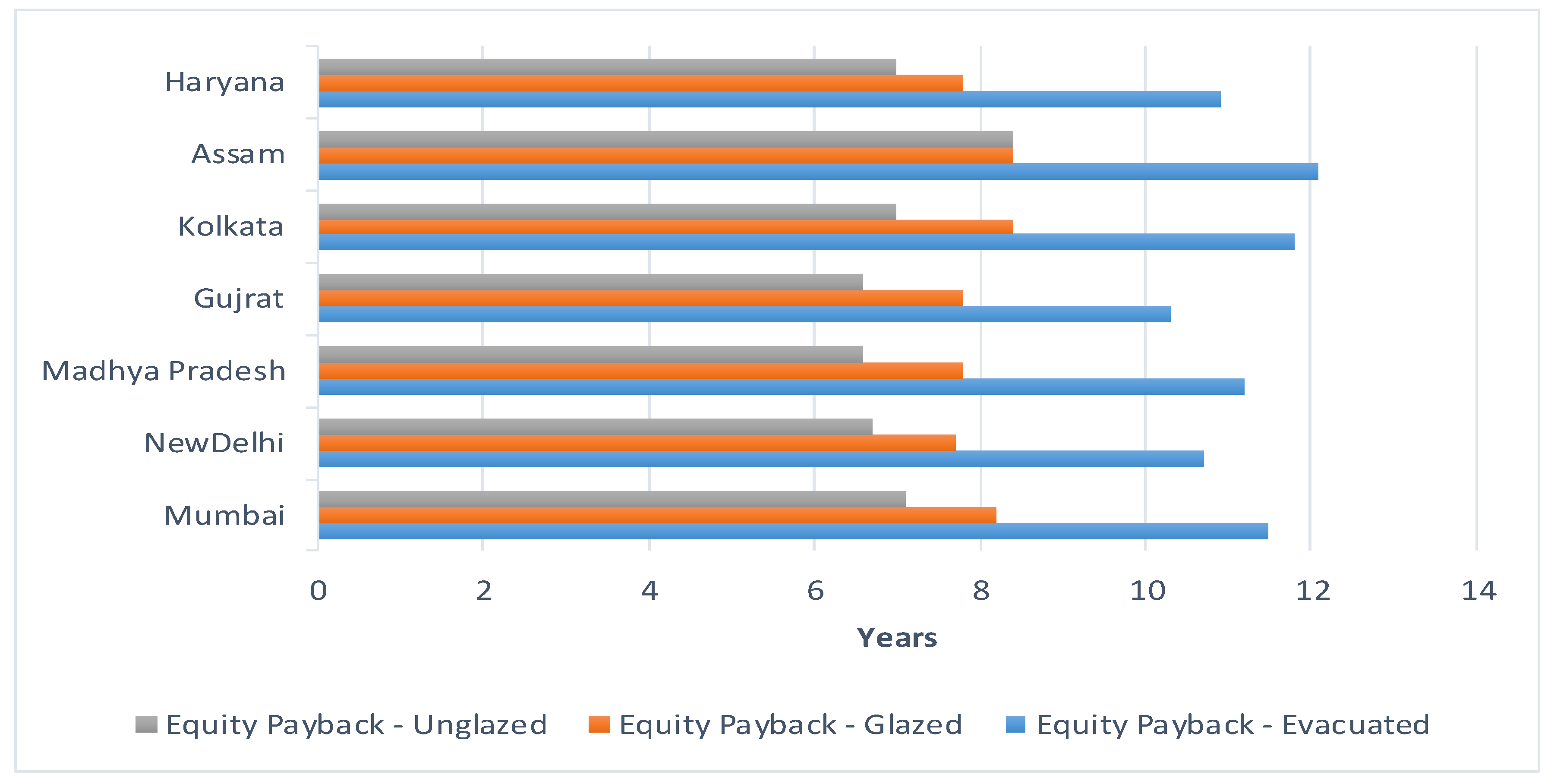
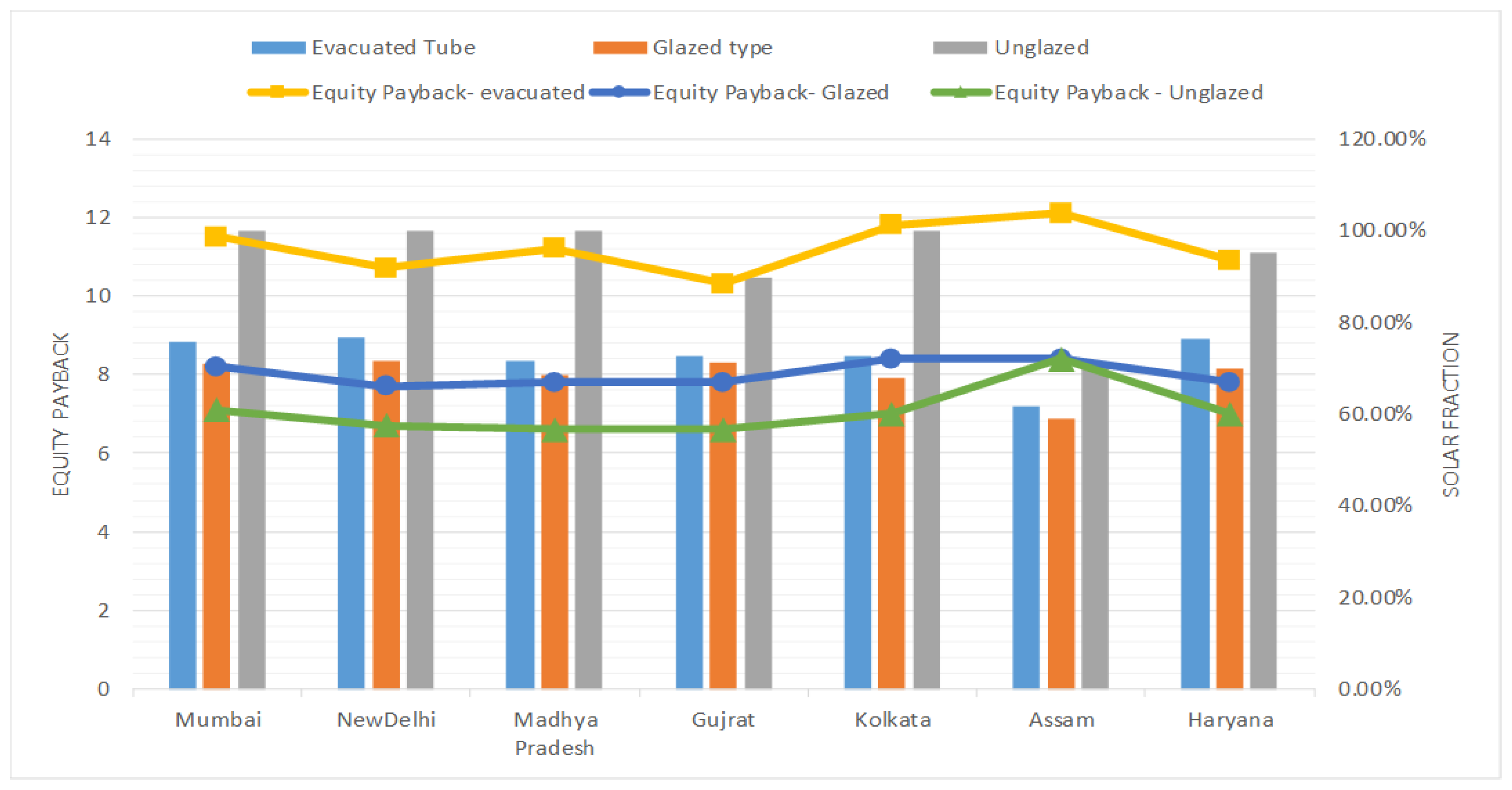
| Location | Mumbai | New Delhi | Madhya Pradesh | Kolkata | Assam | Haryana | Gujrat |
|---|---|---|---|---|---|---|---|
| Latitude | 19.1 N | 28.6 N | 21.2 N | 22.5 N | 25.9 N | 28.8 N | 32.3 N |
| Longitude | 72.8 E | 77.1 E | 81.6 E | 88.3 E | 92.9 E | 78.8 E | 75.6 E |
| Average Air Temperature (°C) | 27.5 | 25.5 | 26.2 | 26.9 | 22.1 | 25.5 | 21.2 |
| Average Earth Temperature (°C) | 27.7 | 25.9 | 26.6 | 26.2 | 21.6 | 25.5 | 20.6 |
| Average Solar Radiation—Horizontal (kWh/m2/d) | 5.12 | 5.06 | 5.07 | 4.86 | 4.33 | 5.16 | 5.29 |
| Average Wind Speed (m/s) | 2.2 | 2.5 | 3.0 | 1.4 | 1.2 | 2.9 | 2.4 |
| Collector Type | Evacuated | Glazed | Unglazed |
|---|---|---|---|
| Manufacturer | Shangdong Linuo Paradigma | Soltop Schuppisser | Aquatherm Industries |
| Model | CPC 1512 | Cobra 2.3 m2 | Ecosun 16104 |
| Collector gross area | 2.28 m2 | 2.31 m2 | 4.367 m2 |
| collector aperture area | 2 m2 | 2.05 m2 | 4.367 m2 |
| Fr (τα) coefficient | 0.56 | 0.71 | 0.816 |
| FrUL coefficient | 0.84 (W/m2)/°C | 3.95 (W/m2)/°C | 15.763 (W/m2)/°C |
| Temperature coefficient for FrUL | 0 (W/m2)/°C | 0 (W/m2)/°C | 0.03 (W/m2)/°C |
| Source | DIN 011-7S113R | SPF C300 | 100-2004-012A |
| Parameters | Values |
|---|---|
| No. of occupants | 5 |
| Occupancy rate | 90% |
| Daily hot water use per person | 57 L/Day |
| Temperature | 60 |
| Operating days per week | 7 |
| Solar tracking mode | Fixed |
| Slope | Latitude |
| Azimuth | 0 |
| Miscellaneous losses of collector | 5% |
| Storage capacity/solar collector area | 80 L/m2 |
| Initial costs (min and max) for both evacuated and glazed types | $1200–$6300 |
| Operation and maintenance cost | $20 |
| Fuel type | Electricity |
| Seasonal efficiency | 90% |
| Inflation rate | 3.14% |
| Project life | 20 years |
| Incentives and grants | 0 |
Publisher’s Note: MDPI stays neutral with regard to jurisdictional claims in published maps and institutional affiliations. |
© 2020 by the authors. Licensee MDPI, Basel, Switzerland. This article is an open access article distributed under the terms and conditions of the Creative Commons Attribution (CC BY) license (http://creativecommons.org/licenses/by/4.0/).
Share and Cite
Raza, S.A.; Ahmad, S.S.; Ratlamwala, T.A.H.; Hussain, G.; Alkahtani, M. Techno-Economic Analysis of Glazed, Unglazed and Evacuated Tube Solar Water Heaters. Energies 2020, 13, 6261. https://doi.org/10.3390/en13236261
Raza SA, Ahmad SS, Ratlamwala TAH, Hussain G, Alkahtani M. Techno-Economic Analysis of Glazed, Unglazed and Evacuated Tube Solar Water Heaters. Energies. 2020; 13(23):6261. https://doi.org/10.3390/en13236261
Chicago/Turabian StyleRaza, Syed Ali, Syed Sulman Ahmad, Tahir Abdul Hussain Ratlamwala, Ghulam Hussain, and Mohammed Alkahtani. 2020. "Techno-Economic Analysis of Glazed, Unglazed and Evacuated Tube Solar Water Heaters" Energies 13, no. 23: 6261. https://doi.org/10.3390/en13236261
APA StyleRaza, S. A., Ahmad, S. S., Ratlamwala, T. A. H., Hussain, G., & Alkahtani, M. (2020). Techno-Economic Analysis of Glazed, Unglazed and Evacuated Tube Solar Water Heaters. Energies, 13(23), 6261. https://doi.org/10.3390/en13236261








